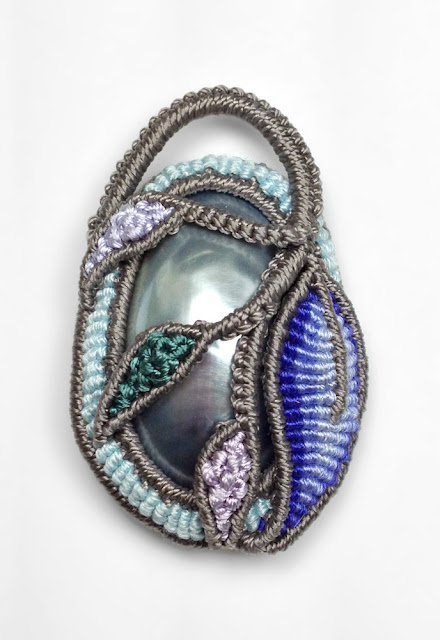Anaito Mini-Card Set - 30 Colors Set with 8m Mini-Cards
As an macrame Cavandoli jeweler, I have been working with the "Anaito" Kanagawa 1000 Denier Embroidery Silk for my whole adult life and it is the very best button hole twist thread available in a wide range of colors. I have started importing it directly from the Kanagawa factory this year and I have learned a lot about this thread in the process. Now in addition to the 20 m Anaito silk cards, I am also importing two new products: Anaito Mini-Card Sets, the same silk already available in 20 meter cards, and Temari Silk, a 2-ply silk thread available by cards or as a full set.
I just imported this new silk collection. I can't wait to experiment with it.
Let's compare these two silk thread and learn about thread terms that help understand how these thread are made.
Thread Construction
The KNK Anaito and Temari Silk are made out of filament or reeled silk.
Filament or reeled silk - It means that it is made out of the silk filament reeled out of the cocoon into a continuous fiber. The cocoon has to be of the highest quality, otherwise the filament break.
Anaito - That means buttonhole twist thread in Japanese.
Temari refers to Temari balls, a traditional embroidery thread craft in Japan.
Denier - A unit of weight for thread and cord based on grams per 9 Kilometers whereas the newer Tex unit is grams per 1 kilometer. 1000 Denier corresponds to 111 Tex. (It is a weight measurement so do not use it to compare different type of thread such as nylon versus silk or cotton... Also it is not a diameter nor a tensile strength measurement.)
As you can see, Anaito is made with a 3-ply twisted construction. If you split the thread it separates into 3 parts called plies. If separated further, each of these plies are made out of 12 plies and those plies are made out of silk yarn that is 27 Denier in weight.
If you want to think about it, from a construction point of view, 27 Denier worth of silk yarn (or silk hair, thats the filaments) are first twisted, and 12 of these are plied or twisted in the opposite direction together making a 324 Denier thread (27 d x 12). Then 3 of these newly made thread are twisted and plied together into the final 1000 Denier thread (27d x 12 x 3 = 972d, simplified to the closest round number of 1000.
Whereas, Temari Silk has a 2-ply construction, and one additional process along the way, as the filaments are twisted and plied 4 times along the way versus 3 times for the Anaito Silk.
Kanagawa Anaito vs Fujix Tire #16 Buttonhole Silk - Fujix Tire #16 Buttonhole Silk is composed of 20d x 16 x 3 = 960d, simplified to 1000 Denier.
Twist per Inch - In addition, Anaito is a tighter thread with more twist per inch. This means that when Anaito was twisted into its final 3 ply, more torsion was applied or each plies was given more turns per inch or centimeters, making it a tighter more compact thread. Temari is more softly spun, with less turns per inch or cm, giving the silk a loftier feel. More twist per inch make a more compact thread. Less a loftier one.
2 Ply vs 3 Ply - 2-ply has more sheen and texture, and is oval in shape. 3-ply is round in shape and has a bit less sheen. 3 ply thread is stronger than 2-ply thread.
Card Sizes - Compare card sizes and thread output.
Washing - Both of these silks are can be washed by hand and have permanent dyes that will not bleed when washed. I use lukewarmm water with mild detergent or shampoo. For tougher stains such body oils, try Synthrapol, a detergent with some isopropyl alcohol in it. I keep some on hand to restore any jewelry made with silk thread.
Light - The dyes are however light sensitive and will fade with extended exposure to direct sunlight.
Applications - Based on all of this info, here is my recommendations:
Stringing Beads - Anaito - With or without knots in between, and only with beads with no hard or abrasive edges. If it is too thin, double or triple it or ply it into a 2 or 3 ply cord. Temari not recommended.
Tassels - Anaito - Perfect for flowy tassels. Temari Silk has not been tested yet.
Braiding - Kumihimo - I have braided pieces with Anaito silk without beads. It is gorgeous. Think of it for a very special ceremonial piece worn just a few time a year. Make sure to include a central core, so the silk is not under undue tension. Temari Silk not tested yet.
Bead Crochet - Some of my customers have done beaded crochet with the Anaito silk. I have not. Temari Silk not tested yet.
Bead Knitting - Some of my customers have knitted beaded evening purses with the Anaito silk. I have not. Temari Silk not tested yet.
Bead Embroidery - Some of my customers have done beaded embroidery with the Anaito silk. I have not. Temari Silk not tested yet.
Surface Embroidery - Both silks are perfect.
Flowers and Leaves Medallion with C-Lon Bead Cord,
Madeira Silk Floss, and Anaito Silk
©2015-2021 Marion Hunziker-Larsen
Cavandoli Knotted Jewelry - Anaito silk works well, so will the Temari Silk. The additional sheen will be one more thing to play with. I use C-Lon Bead Cord as a base and knot over it with various silks.



















2 comments:
I am not quite following your comment in the 2ply vs 3ply section
"3ply thread is stronger than 3ply thread" !!
Thank you Cheers
Thanks for the comment. I just corrected the typo. I meant to say that 3-ply is stronger than 2-ply.
Post a Comment